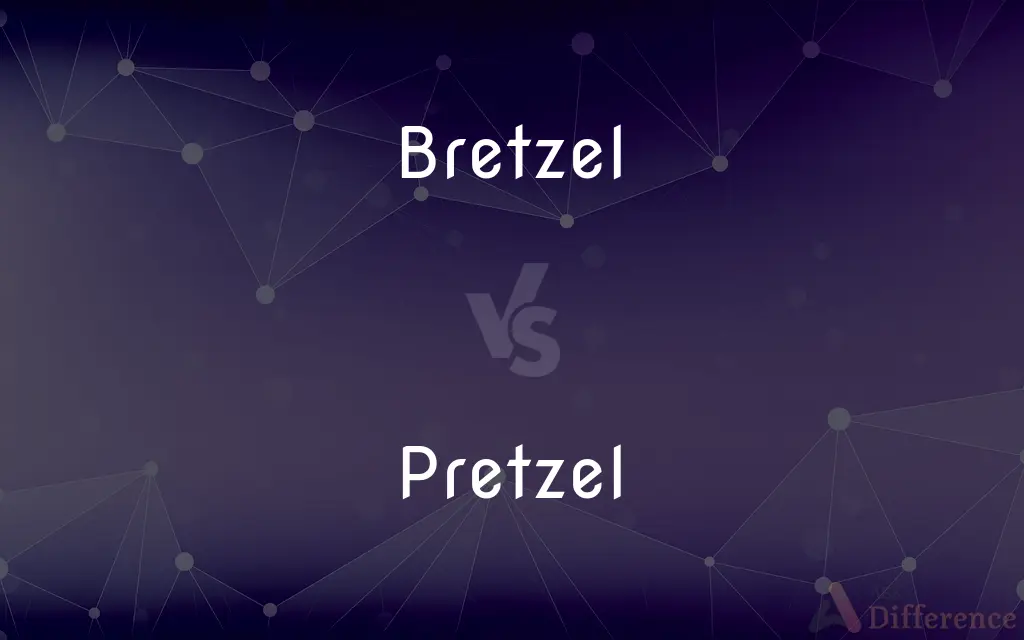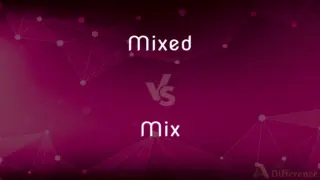Bretzel vs. Pretzel — What's the Difference?
By Tayyaba Rehman & Urooj Arif — Updated on March 11, 2024
Bretzel and Pretzel refer to the same type of baked pastry, but "Bretzel" is used in some European languages, while "Pretzel" is the English and American term.

Difference Between Bretzel and Pretzel
Table of Contents
ADVERTISEMENT
Key Differences
Bretzel is a term commonly used in German-speaking countries and some parts of Europe to describe a type of baked bread product made from dough most commonly shaped into a twisted knot. The Bretzel is known for its distinctive shape, and its surface is often shiny and can be sprinkled with salt, sesame seeds, poppy seeds, or cheese. On the other hand, the Pretzel in the American context often refers to the same baked good but can also include a wide variety of shapes, including sticks, loops, and nuggets. The American pretzel can vary from soft and bread-like to hard and crispy, and it is frequently enjoyed as a snack, often flavored with various seasonings beyond the traditional salt.
The traditional Bretzel is often associated with specific regions, particularly in southern Germany, Alsace, and parts of Switzerland, where it plays a significant role in local cultures and traditions. These regions may have unique variations and ways of preparing Bretzels, sometimes using different types of dough or toppings. Whereas, the Pretzel has been widely adapted in the United States and other countries, leading to a diverse range of types, from soft pretzels sold in bakeries and street stands to hard, packaged pretzels that come in various flavors and are a popular snack food.
Both the Bretzel and the Pretzel involve a unique baking process where the dough is boiled in water mixed with baking soda before baking. This step gives the crust its dark color and distinctive taste. However, the specific methods and ingredients can vary slightly between traditional European Bretzels and American Pretzels, affecting the texture, flavor, and appearance of the final product.
Cultural significance also differs, with the Bretzel often being a symbol of good luck, prosperity, and a staple during specific celebrations and festivals in Germanic regions. In contrast, the Pretzel has become a symbol of snack food culture in the U.S., associated more with casual snacking, sports events, and convenience rather than specific cultural or religious traditions.
The Bretzel and Pretzel also differ in their global recognition and adaptation. While the Bretzel remains closely tied to its European roots and traditions, the Pretzel, particularly the American version, has seen global spread and is recognized and consumed worldwide, with variations catering to local tastes and preferences.
ADVERTISEMENT
Comparison Chart
Term Usage
German-speaking countries and parts of Europe
English and American term
Shape and Variety
Traditionally twisted knot, regional variations
Includes knots, sticks, loops, nuggets, etc.
Types
Mainly soft, bread-like
Ranges from soft to hard and crispy
Cultural Significance
Strong in Germanic regions, symbols of tradition
Casual snack culture in the U.S., sports events
Preparation Process
Boiled in baking soda water, then baked
Similar process, but variations in recipe
Global Recognition
Closely tied to European traditions
Widely recognized and adapted globally
Compare with Definitions
Bretzel
Symbol of good luck and prosperity in Germanic regions.
Bretzels are often given as gifts during New Year celebrations in Germany.
Pretzel
A twisted baked bread snack, popular in the U.S.
Soft Pretzels are a must-have at any American baseball game.
Bretzel
Traditional European bread pastry, often shaped into a knot.
The bakery in Munich is famous for its freshly baked Bretzels.
Pretzel
Often flavored with more than just salt, including cheese, garlic, and herbs.
The garlic parmesan Pretzel was deliciously aromatic and savory.
Bretzel
Variations exist based on regional traditions.
In Alsace, the Bretzel can be topped with cheese or seeds for extra flavor.
Pretzel
Comes in various forms, including hard, crunchy snacks.
Flavored Pretzel sticks are a favorite snack for movie nights.
Bretzel
Integral to festivals and cultural events.
During Oktoberfest, Bretzels are a popular accompaniment to beer.
Pretzel
Adapted globally, with local variations in flavor and form.
Chocolate-covered Pretzels are a sweet twist on the traditional snack.
Bretzel
Generally soft and bread-like, with a shiny crust.
The Bretzel had a soft, chewy texture with a hint of saltiness on the crust.
Pretzel
A casual snack associated with convenience and comfort.
Grabbing a Pretzel at the mall is a quick and satisfying treat.
Bretzel
Dated form of pretzel
Pretzel
A pretzel (listen ), from dialectal German pronunciation, standard German: Breze(l) (listen and French / Alsatian: Bretzel) is a type of baked pastry made from dough that is commonly shaped into a knot. The traditional pretzel shape is a distinctive symmetrical form, with the ends of a long strip of dough intertwined and then twisted back onto itself in a particular way (a pretzel loop or pretzel bow).
Bretzel
See Pretzel.
Pretzel
A soft or brittle glazed biscuit that is usually salted on the outside and baked in the form of a loose knot or stick.
Pretzel
(culinary) A toasted bread or cracker usually in the shape of a loose knot.
Pretzel
(by extension) Anything that is knotted, twisted, or tangled.
Pretzel
To bend, twist, or contort.
They discovered a snake pretzelled into knots.
Pretzel
A kind of German biscuit or cake in the form of a twisted ring, salted on the outside.
Pretzel
Glazed and salted cracker typically in the shape of a loose knot
Common Curiosities
Are Bretzel and Pretzel the same thing?
Bretzel and Pretzel refer to similar baked goods, but the term and certain characteristics can vary by region and language.
Do Bretzels always come in a twisted knot shape?
The twisted knot is traditional, but regional variations may present different shapes.
Can you find soft Bretzels outside of Europe?
Yes, soft Bretzels, similar to European ones, can be found in specialty bakeries and some markets outside of Europe.
Why is it called Bretzel in some places and Pretzel in others?
"Bretzel" is the term used in German-speaking countries, reflecting its origins, while "Pretzel" is the English adaptation of the word.
Are there sweet versions of Bretzels?
Yes, both Bretzels and Pretzels can be made in sweet versions, often coated with sugar, chocolate, or cinnamon.
Are all Pretzels salty?
While salt is a traditional topping, Pretzels can also come in sweet varieties or with various other seasonings.
Is the Pretzel originally from the United States?
The Pretzel has European origins, particularly from German-speaking regions, but has been widely adapted and popularized in the U.S.
Do Bretzels have a religious significance?
In their history, Bretzels were associated with Lent in Christian traditions due to their simple ingredients.
Are Pretzel snacks available worldwide?
Yes, due to their popularity, especially the American versions, Pretzel snacks are available in many countries worldwide.
Can Pretzels be considered healthy snacks?
Depending on the ingredients and toppings, some Pretzels can be a healthier snack option, particularly those that are baked and lightly salted.
What makes the crust of a Bretzel shiny?
The boiling in baking soda water before baking gives the Bretzel its shiny crust.
How are hard Pretzels made crispy?
Hard Pretzels are baked for a longer time at a lower temperature to remove more moisture, resulting in a crispy texture.
Can Bretzels be homemade?
Yes, with the right recipe and techniques, Bretzels can be made at home.
Is it common to eat Pretzels with beer?
Yes, particularly in Germanic cultures and American sports events, Pretzels are often enjoyed with beer.
Do Bretzels and Pretzels always contain gluten?
Traditional recipes contain gluten, but there are gluten-free versions available made with alternative flours.
Share Your Discovery

Previous Comparison
Mixed vs. Mix
Next Comparison
Poster vs. ChartAuthor Spotlight
Written by
Tayyaba RehmanTayyaba Rehman is a distinguished writer, currently serving as a primary contributor to askdifference.com. As a researcher in semantics and etymology, Tayyaba's passion for the complexity of languages and their distinctions has found a perfect home on the platform. Tayyaba delves into the intricacies of language, distinguishing between commonly confused words and phrases, thereby providing clarity for readers worldwide.
Co-written by
Urooj ArifUrooj is a skilled content writer at Ask Difference, known for her exceptional ability to simplify complex topics into engaging and informative content. With a passion for research and a flair for clear, concise writing, she consistently delivers articles that resonate with our diverse audience.
















































